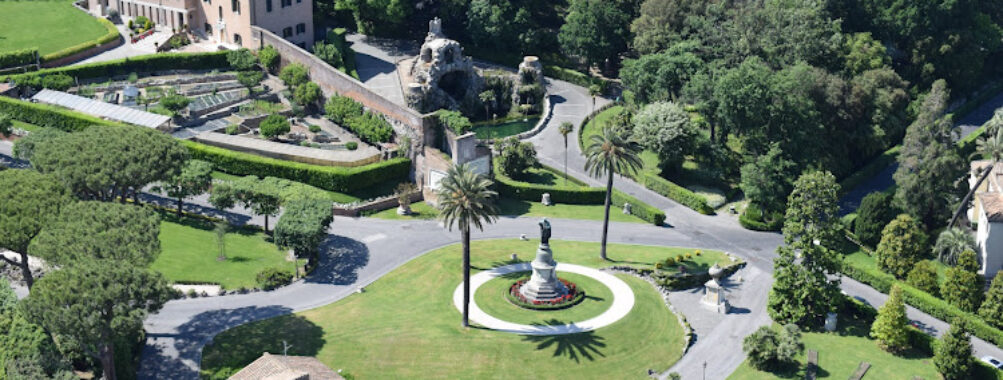
Gardens of Vatican City
Table of Contents
Description
The Gardens of Vatican City are not your typical city park. They’re centuries-old sanctuaries of calm that date back to the 13th century, designed long before the hustle and bustle of modern Rome surrounded them. What makes them fascinating is how they blend history, religion, and artistry into one living space. Imagine Renaissance and Baroque fountains whispering in the background, sculptures peeking through hedges, and winding paths that feel like they’ve been walked by popes, cardinals, and countless gardeners over the years. It’s not just a garden—it’s a storybook of faith and power written in flowers, marble, and stone.
Walking through the gardens, you’ll notice how carefully curated they are. Every corner feels intentional, whether it’s a perfectly trimmed hedge framing St. Peter’s Basilica in the distance or a fountain that suddenly appears around a bend. And yet, despite the precision, there’s a softness to the place. Birds flutter about, the smell of pine and roses lingers in the air, and for a moment, you forget you’re in the smallest country in the world. Some visitors walk away in awe, others think it’s more about the symbolism than the sights—but that’s the thing, the Gardens of Vatican City aren’t meant to be flashy. They’re meant to make you pause, breathe, and reflect.
Key Features
- Historic origins dating back to the 13th century, with layers of Renaissance and Baroque artistry woven throughout.
- Elaborate fountains and sculptures that tell stories of faith, mythology, and papal legacy.
- Panoramic views of St. Peter’s Basilica and Vatican landmarks framed by lush greenery.
- Quiet walking paths where you can escape the crowds of the Vatican Museums.
- Botanical diversity, with Mediterranean plants, roses, and centuries-old trees providing shade and fragrance.
- Exclusive access—entry is limited and only possible with guided tours, so it never feels overcrowded.
- Wheelchair-accessible entrances and parking, along with public restrooms for convenience.
- A family-friendly environment where children can explore open spaces safely.
Best Time to Visit
If you’ve ever been to Rome in July or August, you’ll know why I say this: avoid the peak summer heat if you can. The gardens are outdoors, and while there’s shade, the Roman sun has a way of making you feel like you’re baking in an oven. Spring and autumn are the sweet spots. April and May bring blooming flowers and pleasant breezes, while September and October give you golden light and fewer tourist crowds. Winter has its charm too—quiet, cool, and contemplative—but you won’t see the same lushness. Personally, I’d pick a crisp fall morning. There’s something magical about watching the sun rise over the Vatican domes with the gardens still waking up.
How to Get There
Reaching the Gardens of Vatican City is easier than you might think, though you can’t just stroll in like a public park. Entry is only possible through guided tours arranged with the Vatican Museums. If you’re already planning to see the Sistine Chapel or the Vatican Museums (which most travelers are), you can book a combined ticket that includes the gardens. Once inside Vatican City, it’s simply a matter of following your guide through the gates and into the green heart of the world’s smallest country.
Most people arrive by metro, getting off at Ottaviano or Cipro stations, then walking a few minutes to the Vatican entrance. Buses and taxis are also options if you’re not up for the walk. Just remember, security checks are part of the process, so give yourself extra time. Nothing ruins a serene garden visit like rushing because you underestimated the line outside.
Tips for Visiting
Here’s where I get a little personal. The first time I visited, I rushed through because I had another tour scheduled right after. Big mistake. The gardens are not the place to be in a hurry. So my number one tip: slow down. Let yourself wander, listen to the fountains, and actually sit on a bench for a few minutes. You’ll get more out of it than snapping a hundred photos.
Wear comfortable shoes. The paths are well-kept, but you’ll be walking quite a bit. Bring water, especially if you’re visiting in warmer months. And while you can take photos, remember this is still Vatican territory—a place of reflection and spirituality—so be respectful in how you move around.
Another thing: book early. Tours to the gardens are limited, and they sell out faster than you’d expect. If you’re traveling with kids, the gardens are a surprisingly good choice—they can stretch their legs and run around without the claustrophobic museum crowds. And for those with mobility needs, the Vatican has made the gardens accessible with wheelchair-friendly entrances and parking, which isn’t always the case with historic sites in Rome.
Finally, go in with the right mindset. If you’re expecting Versailles-style grandeur, you might be underwhelmed. But if you’re open to the quiet beauty of history and nature intertwined, the Gardens of Vatican City will leave a lasting impression. For me, it wasn’t about the fountains or the sculptures—it was about the sense of peace I felt in the middle of one of the busiest tourist destinations on Earth. That’s rare, and that’s what makes it worth your time.
Location
Places to Stay Near Gardens of Vatican City
Find and Book a Tour
Explore More Travel Guides
No reviews found! Be the first to review!